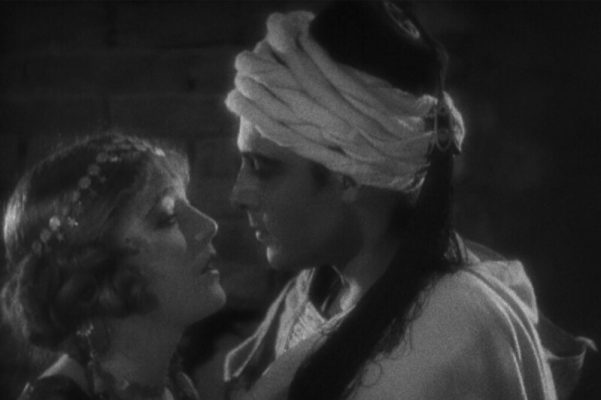We are somewhere ‘south of Algiers’. There’s a desert encampment, the old souk, untrustworthy bandits with surly glances and coquettish slave girls. For audiences in the 1920s this must have been an enormous epic. Not only did it feature one of the first superstars, Rudolph Valentino, playing the nameless son (and his father in split screen); but dastardly baddies, comic relief in the form of a clowning dwarf, bare midriffs for the women and galloping horses in the moonlit desert. There’s whips and hints of barely-consensual ravishment. This was pre-code Hollywood where violence and libidinous activity, though never explicit, was celebrated. In the extras video essayist David Cairns calls the movie Fifty Shades of Grey for the Jazz Age.
The story is a daft melange of abductions and double-dealing and passions and swooning and google eyes. But it is also one of the last hurrahs for the silent movies. And it’s all beautifully done. The desert locations (it’s Yuma not the Sahara) are splendidly captured in George Barnes’ fluid camerawork and the early split-screen trickery was pioneering. It’s also easy to see why Valentino so mesmerised female audiences. Here he is a kind of do-or-die Lawrence of Arabia figure. Even by standards of the silent Valentino was no great actor. He just needed to smoulder and look in the right direction. His fans ran riot in the streets when he died a year after the film’s release at the age of 31. Then the cinema reinvented itself thanks to synchronised sound.
The racial and sexual stereotypes inevitably don’t pass muster nearly a hundred years on but back then the exoticism of the mysterious East held real sway. Could there be anything more colourful than belly dancers with bare feet and Arabs with jewel-encrusted daggers between their teeth? Cinemas were often made to look like something out of Moorish Spain or Baghdad. And the romantic sheik was so potent he was regularly spoofed in shorts of the time.
Yet for all its faults the movie stands up better than some later talkies. And this beautiful restoration is enhanced by Carl Davis’s orchestral score.
Available on Dual-Format Blu-ray/ DVD Mon 17 Feb 2020
